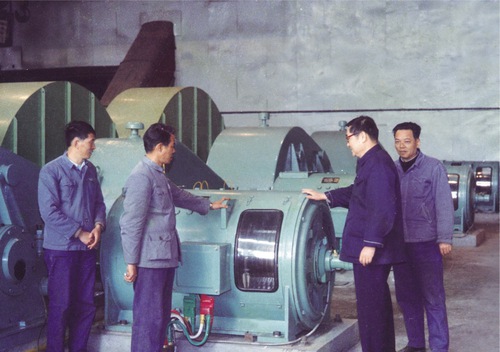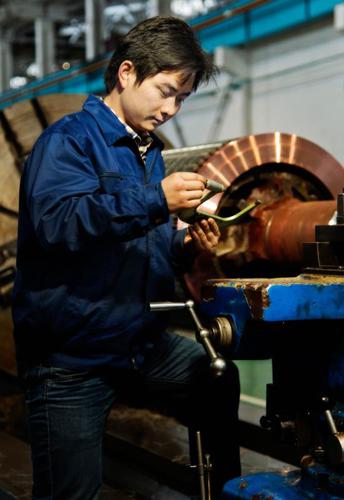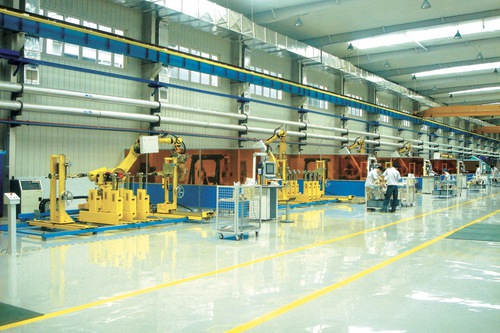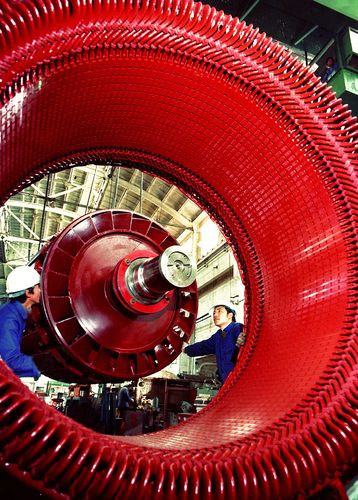Recently, Shanghai Electric Machinery (SEM) has installed and debugged its last motor in Zhongwei Station, as part of the West–East Gas Pipeline Project. This marks the completion of SEM's three 20MW ultra-high-speed explosion-proof variable-frequency synchronous motors provided for the Zhongwei Interconnectivity Project.
It used to be that for every few hundred kilometers along the West–East Gas Pipeline that stretches thousands of kilometers, there would be an ultra-high-speed explosion-proof motor supplied by multinational companies, such as Siemens or GE, to power the transportation of natural gas. Now, SEM's motors have replaced such foreign brands.
The present successes—praise from the National Energy Administration and numerous new orders initiated by buyers—have got SEM thinking about the bold move several years ago: to take on both the opportunities and challenges of the West–East Gas Pipeline Project, which no other companies in China dared to face. What if they lose out? Wouldn't it just be an unnecessary risk? To make a prompt decision without hesitation, heads of SEM said, "All the credit goes to you if you win, and we'll take the blame if you lose." This assured the team of the West–East Gas Pipeline Project.
These are the words that echo in the minds of some senior workers. In that year, to address the worries of the Director of Guangdong Shunde Sugar Factory, Li Wenhua, the then Director of SEM, said, "Telegraph me if anything goes wrong, and I'll come over to Shunde in person and get beaten by shoulder poles with you." Later on, the "shoulder pole motor spirit" was widespread throughout China in the early period of the reform and opening-up to the outside world in the 1980s.
About the "shoulder pole motor spirit"
To adapt to the general shift from a planned economy to a market economy, early in 1981, SEM sent out a large number of sales and technical staff to large manufacturing and mining enterprises in large cities all over China to conduct market research.
In a review meeting for the market research in March that year, Director Li Wenhua learned from a report that China had a promising economy following the Third Plenary Session of the 11th CPC Central Committee, and sugarcane farmers in the southern provinces were glad for the great harvest, but the devices in the factories were outdated with sugar refining capacity lagging far behind market demand.
SEM then sent a survey team to Guangdong Shunde Sugar Factory. Led by Li Wenhua, the team was shocked at the outdated steam engines used in the "No. 1 Sugar Factory" for sugar making. According to Li Wenhua, they could be replaced with motors at the price of about RMB 1,000 each, while such motors only played a small part in SEM's product lineup. What was more, the sugar factory needed an enclosed motor. Due to the low usage, high technical requirements, and small profits, it was known as a tasteless "old beef tendon" getting stuck in your teeth. However, the reform and opening-up were the general trend although the curtain had been lifted only a few years ago, and the days for companies completely relying on state-led plans to always get an equal share would never come again. The only way out for large state-owned enterprises was to find a niche market outside the factory.
Hence, Li Wenhua, together with heads of the sugar factory and two engineers, immersed themselves in the production workshop for surveys, measurements, and calculations. The work kept them very busy and they soon obtained a large amount of firsthand data. This allowed them to modify the plan which used DC motors with a silicon rectifier power supply.
Though the plan was in place, they came across a bottleneck regarding the turnaround time. It was already May and the sugar factory usually began refining in October. This left SEM with only five months to complete the production when the normal production period for a medium DC motor was at least 9 months. What should they do? Should they try to meet the user needs on time, or "beat a retreat"? After a trade-off analysis, Li Wenhua made a prompt decision: they undertook to deliver the goods on schedule and ensure on-time refining, and signed the contract.
The survey team immediately got to work on technical solutions as soon as they returned to the factory. At that same time, the Sugar Factory Director traveled the great distance to Shanghai and said to Li Wenhua with a heavy heart, "Mr. Li, since you left, I haven't been able to eat or sleep and tossed about in my anxiety. I've just kept thinking about it and had to come to you. What if you cannot deliver on time? What if the refining cannot start on time and someone will have to make up for the losses caused to the farmers and those to the factory? You should know there'll be thousands of furious sugarcane farmers ready to beat me to death with their shoulder poles!" Li Wenhua listened and then replied categorically, "We will honor our words and deliver on time so you can start the refining on time. If something goes wrong, I'll certainly go to Guangdong to endure the shoulder poles instead of you; if anyone has to be beaten to death, that'll be me!"
He made the promise there and then. It was no mean feat to shorten the production period from 9 months to 4 months. The next day, Li Wenhua mobilized all the employees of the factory to shoulder more responsibilities and join the battle against being beaten by shoulder poles. He named such motor a "shoulder pole motor."
The battle then started. Li Wenhua asked the Manufacturing Department to mark an upright triangle on the construction plan, meaning "urgently needed" and a go-ahead for production. The Supply Section completed the supply of 6 kinds of electromagnetic wire in only 40 days, which halved the time generally needed. The production workshops were also racing against time, and concurrent operations for adjacent processes were ongoing to keep up with the schedule and guarantee the quality. By the end of July, the first batch of motors were finished and their performances exceeded the national standards as confirmed in the test run. In August, just before the sugar cane were ripe, the motors arrived at Shunde Sugar Factory on time and were installed and debugged successfully in the factory, which guaranteed the on-time sugar refining. SEM also held maintenance training sessions for the would-be users of the motors. The Sugar Factory Director said joyfully, "Well done, SEM!"
After the upgrade to the motors, the sugar factory was able to refine 500 tons more sugarcane a day, making that 50 thousand more tons a year and an increase in income of one million yuan. Besides, their coal consumption would drop by 43%, saving 3,800 tons of raw coal per year. This meant that they could recoup their cost of the technical upgrading in only one year. Looking at the "shoulder pole motors," a sugar factory worker tightly held the hand of an SEM technician and said as his eyes welled up, "We've progressed from the age of steam to that of electricity in the blink of an eye."
Media in Shanghai, Guangdong, and Guangxi extensively covered the successful upgrade in Shunde Sugar Factory. Yet, Li Wenhua was never complacent. In accordance with South China's humid climate and the working requirements of sugar refining, he and his R&D staff decided to redesign an offshoot series more suited to the sugar factory's technical improvements. Soon after, lots of southern sugar factories heard the news and ordered a large quantity of "shoulder pole motors" from SEM. Thereafter, Shanghai's motors gained a reputation, and established a strong foothold in the South China market.
On New Year's Day, 1983, the Economic Daily released its first issue, and the inaugural statement by Vice Premier of the State Council Wan Li was titled "A Tribute to the Shoulder Pole Motor Spirit." Wan Li highly praised Shanghai Electric Machinery and Director Li Wenhua, for their courageous exploration into the market and their spirit of serving the users whole-heartedly, which he called the "shoulder pole motor spirit."
Following that, the National Machinery Industry Commission, Shanghai Municipal Government, and Shanghai Mechanical and Electrical Bureau all issued official documents requiring all industries to study and carry forward the "shoulder pole motor spirit," while hailing the spirit as a "bud" for state-owned enterprises striving to prosper in a socialist market economy.
Breaking up the international monopoly
For every few hundred kilometers along the West–East Gas Pipeline, there is a compressor station, which pressurizes the gas for long-distance transportation. However, the supporting motors for the compressor stations had long been monopolized by multinational companies such as Siemens and GE. The key devices running online had all been imported at an extremely high price. According to the China National Petroleum Corporation, a single pipeline of the Project required an investment of hundreds of billions of yuan, and the equipment investment alone equaled the price of 24 Boeing 747 planes (each plane costs about USD 300 million). The government had detected excessive investments and high maintenance costs while auditing the West–East Gas Pipeline Project, which necessitated the independent production and supply of crucial core devices. Besides, compressor stations maintain the daily operation of the large-scale West–East Gas Pipeline Project, which makes it a matter of vital importance to the national economic security.
The biggest challenge facing the motor research, development, and design team for the "West–East Gas Pipeline Project" was how to increase the rotational speed. Conventional motors rotate at 3000 rpm. However, the motors for the West–East Gas Pipeline Project must rotate at 5040 rpm. At such a high speed, the linear speed for the rotor outer circle would be more than half of the speed of sound in air. Any component flying off would become a "bullet." In China, there was neither a theoretical database to consult nor source materials to choose from. Thus, starting with the technical roadmap, each step had to be taken from scratch.
With a history of nearly 70 years, as old as the People's Republic of China, SEM has always dared to be the first. For employees at SEM, the ultra-high-speed explosion-proof motor for the West–East Gas Pipeline Project is like a "shoulder pole motor" for the new era. It is a major breakthrough under the pressure of foreign monopolies.
The hard-working research, development, and manufacturing process has remained unchanged. Back in the 1980s, the Factory Director once brought his bedding into the workshops. Nowadays, some workers rent rooms beside the work site and live alone there, devoting themselves to the West–East Gas Pipeline Project. Others had to switch 4 metro lines to commute every day, departing from home at 5 in the morning, and getting back after 10 at night.
In November 2012, SEM developed China's first 20MW 4800 rpm ultra-high-speed explosion-proof variable-frequency synchronous motor, breaking up the long-term foreign monopoly in terms of high-power, high-speed rotation, variable-frequency electric compressor units. Thereafter, SEM has provided nearly 20 ultra-high-speed explosion-proof synchronous motors for the construction of national natural gas pipelines. They have been used in the West–East Gas Pipeline II, West–East Gas Pipeline III, and many other gas pipeline projects. Last winter, Central Asia's large reduction of its supply of gas to China and the implementation of the policy on the switch from coal to gas in Northern China led to the surging demand for natural gas and thus a gas shortage all over the country. Against this backdrop, PetroChina has accelerated its efforts in 33 key interconnectivity projects, and will enable the interconnectivity of West–East Gas Pipelines II & III, Zhongwei–Jingbian Pipeline, and other pipelines of the Zhongwei Interconnectivity Project. This will basically overcome the difficulty in transporting gas from the south to the north.
The construction of the Zhongwei Interconnectivity Project commenced at the end of June 2018 and was planned to go into operations by the end of the year. Hence, manufacturers had to supply adequate devices within a very short time period. The time allowed for motor manufacturing was even less than 4.5 months, which halved the general manufacturing period in the industry. In spite of the greatest difficulties in this key livelihood project of China, SEM took it as an opportunity to increase its market share, and thus made a solemn promise to guarantee the quality, quantity, and on-time delivery. Thus, SEM became the only motor supplier for the project. Through the joint efforts of stakeholders, all the three motors at the Zhongwei Station passed the test run the first time—a satisfactory fulfillment of the contract obligations and customer expectations.
The successful delivery of motors to the Zhongwei Station represents the "shoulder pole motor spirit" in the new era. To survive in the new competitive environment, cornering the market is not enough to do the trick. Instead, a company's overall competitiveness is the key, which entails the combination of innovative technologies and contract fulfilling capabilities. The successful delivery of motors to the Zhongwei Station best displays the boldness and courage of SEM to take on the challenges and responsibilities as needed by the national strategy and corporate transformation.
Rome was not built in a day, and neither was SEM, a factory with the courage to face new challenges. From the pioneering spirit involved in the double-water inner cooling technology, to the courageous "shoulder pole motor spirit" during the transition to a market economy, SEM has gradually shaped its Shanghai-style business culture: always be an unwavering dreamer and an active challenge taker.
- Previous: From a Dependent Learner to an Independent Innovator
- Next: no












 Shanghai PNS registry No. 31010102007087
Shanghai PNS registry No. 31010102007087